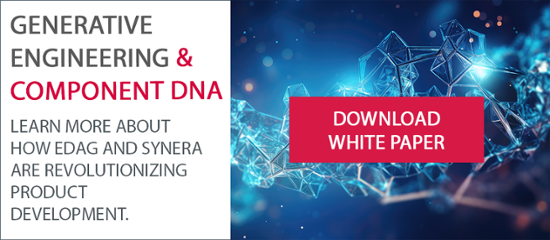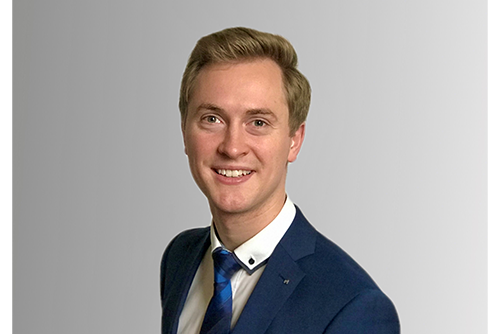What if the design of an electric drivetrain no longer consisted of , a motor, a gearbox and a housing as well as the battery - but simply defined the path to the desired solution? The DNA as a "construction manual" for a generative development process pays off in particular when there is a large number of options to choose from or different variants or derivatives are required . EDAG Drivetrain Systems also relies on Generative Engineering with the help of Synera software in this segment due to the more efficient processes and the higher quality of the results.
Nature has found a way for organisms to adapt optimally to their environments: Evolution. Small, random deviations in the genetic material lead to altered characteristics in subsequent generations. If they offer the organism a noticeable advantage, it has a better chance of reproducing, so that these genetic variants prevail over others.
It is always surprising to see how efficiently Mother Nature goes about solving problems. It is therefore not surprising that engineers try to imitate such strategies in so-called bionic solutions - such as evolution in "generative engineering". Development based on the principle of "survival of the fittest" proves particularly effective in cases where complex problems coincide with a large number of possible options for the components used or with the requirement for multiple variants in the end product.
One example is the development of electric drives, which allow for a large number of influencing factors, but also have to meet a wide variety of requirements. Finding an optimal design here has so far been a complex undertaking - and whether the solution found is actually close to the optimum can hardly be reliably answered.
High complexity - high effort
The drivetrain of an industrial application can be constructed in very different ways. This starts with the electric motor used; the spectrum includes separately excited synchronous machines as well as asynchronous and synchronous motors. The decisive factors are requirements such as torque at the wheel, maximum speed and electrical power values.
The drives are supplemented by different gearboxes with specific combinations of shafts and bearings. And last but not least, different housing variants can also be used. This results in an unmanageable wealth of variants, from which suitable combinations must be developed and the most promising ones sifted out.
The processes used to date are associated with a high level of manual effort. The development of a drivetrain is divided into several subtasks, each of which requires separate iterative processes for decision-making and optimization. It is problematic to take existing dependencies into account in this process. In complex systems, these are difficult to identify, and it is just as difficult to take them into account during development based on the division of labor.
In addition, there is always the risk that models found in this way will prove to be unstable, i.e. that minor changes to boundary conditions will cause the results to "tip" and the solution design to deviate from the optimum . Then the development work has to go back one step further, which leads to lengthy and cost-intensive processes. It is particularly annoying when developing variants and derivatives if the previous solutions can hardly be reused and the development process has to be restarted from the beginning.
Evolutionary processes in drive development
The experts in EDAG's Drivetrain Systems department have found ways to tackle these problems efficiently. They rely in part on an evolutionary process with little manual effort and have created an automated workflow that quickly leads to viable solutions. To this end, they have set up the "EAGEL" project (Electric Drives - Generative Engineering Lighthouse). 
The basis is the description of the entire process as continuous subtasks that all work towards the set requirements and boundary conditions. These serve as a starting point, as DNA so to speak, for generative engineering.
In concrete terms, for the development of a drivetrain, this means that various requirements, including general, transmission, e-machine and housing specifications and requirements, are generated in the form of an Excel spreadsheet. On this basis, a large number of drive concepts are generated within a few minutes. If it turns out that the results do not meet the developer's needs, the concept model can be quickly redesigned by adjusting the specifications. Such an optimization delivers 100 new designs to choose from within 20 minutes.
First, the components (electric motor and gearbox with shafts and bearings) are designed by deriving CAD models, visualizations and lookup tables. Furthermore, the entire system is optimized, for example by finding an ideal gearbox topology depending on the electric motor. In this way, a better and more practicable concept is determined in a shorter time than would be possible with manual improvement steps.
The final output is an optimized 3D parameter model in Synera and CATIA. Due to the high iteration speed, the optimum of the desired development is achieved more quickly. 
More efficiency with generative engineering
The established waterfall model, with its division of labor and sequential phases, is now being replaced by an automated workflow that significantly reduces manual activities. This is because we no longer think in terms of process steps that need to be optimized individually, but in terms of development as an overall process that is subject to a certain set of rules. And this set of rules must be adapted so that it ultimately delivers the optimum results.
Another aspect of this development model is the closer collaboration between the various development teams. It is not uncommon for the division of labor to develop into a silo structure that hinders the exchange of data and makes it difficult to take a 360-degree view of the overall solution. The generative developer approach reverses this trend and establishes a joint process.
EDAG relies on Synera software, with the help of which the entire development process can be set up as an automated workflow. It is no longer the solution itself that is created in the software, but the path to the desired powertrain. In other words, a construction manual is defined as DNA. The workflow can then be run through as often as required, so that the developer no longer has to design each individual drivetrain individually, but instead obtains the optimum solution for the current requirements by making minor adjustments to the boundary conditions.
The advantages are obvious:
- Acceleration of the development process;
- Development of previously unconsidered solutions;
- Better approximation to the optimum.
The efficient use of available skilled workers is a significant competitive advantage, especially in the tight labor market. Not only does this save costs and enable more attractive project prices. It also increases the number and scope of projects that can be completed with the existing team.
Another aspect is the safeguarding of know-how within the company: Employees' knowledge is stored in the code or workflow. This means that it is not lost when know-how carriers leave the company.
Broad field of application for generative processes
This approach, copied from nature, not only allows drive trains to be designed faster, more efficiently and better. EDAG has already successfully implemented this principle in various product areas. One example is the development of hairpin stators for electric motors. With the help of generative engineering, the development time for stators, including the required derivatives, which differ in terms of the number of pins, layers or overall dimensions, for example, could be reduced by up to 50 percent. In addition, the evolutionary process delivered stator models that were significantly lighter than previous solutions, thus helping to ensure that electric motors can be built with less weight.
Another application is the creation of ISOFIX mounts for child seats. The basic principle of the ISOFix system is always the same, so that any ISOFIX-compatible child seat can be attached to it. However, the actual attachment points for the system must be adapted for each body shape and each vehicle. Even small series vehicles and special vehicle derivatives can no longer do without this important safety feature. This results in a wide variety of derivatives, which can be easily managed with the help of generative engineering. The right component can also be designed quickly and easily for new vehicle types and models with slight adjustments to the DNA.
Development of optimal battery storage
The automation of the development process with Synera has also proven to be exceptionally helpful in the field of battery storage systems. This is because many different influencing factors come together when packing the battery cells. For example, the frames for the battery storage system can have different shapes and heights, in addition to the variety of battery cells, which differ in shape and characteristics. There is also the question of which voltage level - 400 V or 800 V - is to be achieved, and how important weight, energy content and peak power are.
Finding the battery concept that best suits the requirements at an early stage of development is very complex and time-consuming. Due to the large number of degrees of freedom mentioned, so many variants are conceivable that it is not possible to calculate them all manually and design them conceptually. It is therefore necessary to make conceptual considerations and limit oneself to a few variants that are likely to produce the best results. From these, the most promising concept can then be selected on the basis of the results obtained and pursued further. However, it is not possible to determine whether this is actually close to the optimum or whether you are a long way from it due to incorrect assumptions and specifications. 
As part of the "BatCon" project, EDAG therefore developed an automated workflow that can test many more variants. The program calculates how the cells can be fitted into the installation space based on the specified requirements, such as nominal voltage and peak power, the installation space specified by the CAD system and a preselection of the 140 cell types stored in a database. The interconnection of the individual cells is also taken into account and other mechanical and electrical properties are calculated. An automated report is created based on the results found, which compares the different properties of the different variants.
The test with the design space developed by EDAG itself revealed a surprising result: that the cell with the highest energy density at cell level does not automatically lead to a battery system with the highest energy density. This is due to packaging-relevant factors, such as possible space utilization, cell spacing to be taken into account and the like. In a subsequent step, the range is determined using Matlab, taking into account not only the capacity but also the weight and other influencing factors. This showed that the concept enables a significantly higher range compared to the initially preferred high-energy cell - an enormous difference when addressing customers. 
Universally applicable tool
And the field of application is far from exhausted. The development experts at EDAG have already considered linking the battery storage calculation with the development of the rest of the drivetrain in a next step, so that the characteristics of the battery are directly incorporated as information in the selection of the engine and transmission. In other words, the workflow will become even more integrated.
In addition, the solutions can also be transferred to development processes for other products or applications if customers show an interest.
Are you also struggling with high costs and lengthy processes in the development of drivetrains or other assemblies? Then talk to our EAGEL expert Michael Schramm, Development Engineer Drivetrain Systems, about the advantages of the new development method. Or download the white paper "Generative Engineering - faster to the component" here, which describes in detail how this concept works, how the workflow can be automated and which tools are used for this. 





